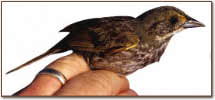Across Trophic Level System Simulation (ATLSS) - Cape Sable Seaside Sparrows
 |
The Cape Sable seaside sparrow (Ammodramus maritimus mirabilis) is an ecologically isolated subspecies of the seaside sparrow (Beecher 1955). Recent surveys estimate a population size of approximately 3000 individuals (from 6000+ in 1992), and its range is restricted to the extreme southern portion of the Florida peninsula, almost entirely within the boundaries of the Everglades National Park and Big Cypress National Preserve (Werner 1975, Bass and Kushlan 1982). The sparrow currently breeds in marl prairies typified by dense stands of graminoid species usually below 1m in height and naturally inundated by freshwater during part of the year. As water levels recede during the dry season in late winter and spring, the sparrows establish territories and start nesting in dense grass tussocks. Several broods may result from a single male territory if hydrologic conditions allow (Lockwood et al. 1997). If water levels do not recede early enough in spring, nesting may be delayed, and if water levels subsequently rise during the nesting season eggs or nestlings may be drowned. Recent declines have occurred in the sparrow population across its entire range, probably due to higher water levels in recent years (Pimm et al. 1995). Because the current range of the sparrow is limited to a few hundred square kilometers and because it is subject to flooding and fires, the population is highly vulnerable. The Everglades restoration project (Hinrichson 1995) plans to change to the hydrology of the southern Everglades. Changing water levels in parts of the sparrow's range would affect the reproductive success of the sparrow.
There are two currently implemented models being applied in ATLSS to analyze alternative hydrologic scenarios on the Cape Sable Seaside Sparrow; the Breeding Potential Index Model and the SIMSPAR - Individual-based model.
Project Summaries
- 2001, 2002 (Individual based spatially explicit model of the Cape Sable Seaside Sparrow population in the Florida Everglades)
Publications
Abstracts:
- Across-Trophic-Level System Simulation (ATLSS) Program Cape Sable Seaside Sparrow Modeling
- Cape Seaside Sparrow Model, SIMSPAR (from the South Florida Restoration Science Forum, May 1999)
- Individual Based Spatially Explicit Model of the Cape Sable Seaside Sparrow Population in the Florida Everglades (from the GEER Conference, December 2000)
Posters/Presentations:
- Cape Sable Seaside Sparrow Spatially Explicit Individual Based Population Model (SIMSPAR) (PowerPoint® file. Presentation from the Ecological Processes and Modeling Information Workshop, May 9-10, 2002)
- Demographical Analysis of the Spatially-Explicit Individual-Based Cape Sable Seaside Sparrow Model (PowerPoint® file. Poster presented at the GEER Conference, December 2000)
- SIMSPAR - A Spatially-Explicit Individual-based model for the Cape Sable Seaside Sparrow (PowerPoint® file. Poster from the South Florida Restoration Science Forum, May 1999)
Related Links
< Back to Main ATLSS Project Page
This page is: http://sofia.usgs.gov /projects/atlss/sparrows/index.html
Comments and suggestions? Contact: Heather Henkel - Webmaster
Last updated: 18 September, 2003 @ 03:25 PM (KP)
